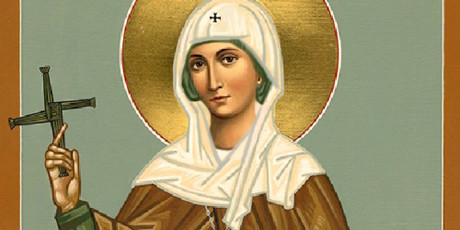Who Was St. Brigid and What Is her Cross?
Posted by Ima Ocon on 30th Jan 2020
February 1 marks a special time in the Irish calendar because it signals the end of winter and the beginning of spring. It’s also the feast day of St. Brigid, a patron saint of Ireland alongside St. Patrick and St. Columcille, so celebrations are in order! While customs during this day have evolved over the years, from placing bread on windowsills to lighting a bonfire, there is one aspect of it that has remained consistent over the years: St. Brigid’s Cross.
A UNIQUELY IRISH CROSS

The traditional St. Brigid's Cross is made from reeds or rushes and is designed to be temporary. (Culnacreann / Wikimedia Commons)
Even without checking the calendar, you’ll know that it’s Feb. 1 when you notice St. Brigid’s Cross popping up everywhere, whether as a symbol in posters or an ornament hanging from doorways. St. Brigid’s Cross doesn’t look like the standard cross that you’d expect. It has a square centerpiece with four radials, and It’s usually made of straw, rushes, or reeds that are woven together in a criss-cross pattern. Each end is tied with a string, then cut to make them even. Ideally, the material itself has already been blessed right before, but it’s also common to sprinkle the finished cross with holy water. You can recite this prayer afterwards: “May the blessing of God, Father, Son and Holy Ghost be on this Cross and on the place where it hangs and on everyone who looks on it.” The cross is often created the day before, on Jan. 31, and children learn early on about its purpose and history because they’re taught how to make it at school.
The meaning behind St. Brigid’s Cross is multilayered. While it’s primarily an Irish Christian symbol, it might have its roots in the pagan sunwheel, which was meant to bless the earth with fertility and life. The centerpiece also recalls the movement of the stars as the year passes, evoking how the Big Dipper rotates slowly around the North Star. However, the main purpose of St. Brigid’s Cross is to protect a house and drive evil, fire, and hunger away. It can also represent peace and goodwill, and it was even placed in cowsheds to safeguard animals and help cows to produce more milk.
Ideally, the cross should be displayed on a visible place. The traditional placement was on the inside of a thatched roof, above the front door, but in modern times, you can simply hang it on the inside of your front door or over the doorway. Look around in old houses and cottages, and you might find darkened crosses covered with dust and cobwebs. Discard (or burn) the cross you have from last year and then keep the new cross for the entire year, until the next arrival of St. Brigid’s Day.
St. Brigid did design the cross herself, as the story goes, but it happened under interesting circumstances. She was visiting an old pagan chieftain who was enduring his last moments on his deathbed. The servants had called upon Brigid to soothe and calm him, and some versions even describe him as her father. She sat beside him, talking to him while picking up rushes from the floor—a common material of Irish homes back then—and then weaving them by hand into a cross. The chieftain noticed the cross and asked her about the cross. As she weaved, she explained what the cross meant, and it captivated him so much that he willingly converted to Christianity and got baptized right before he died.
When the news spread throughout kingdoms and villages, people were in awe of St. Brigid. The cross became a lasting part of Irish culture, and it was even the logo of RTÉ, Ireland’s national broadcasting TV station, for quite some time. It has been featured in various Irish designs, including jewelry and art. In fact, ShamrockGift offers St. Brigid Cross as a necklace with its pendant made of silver and gold, bringing the protective powers of the cross to your own person. For blessing your house, the bronze-plated St. Brigid’s Cross Plaque is available, as well as the hand-painted St. Brigid’s Cross Ornament, which is made of fine porcelain.
WHO WAS ST. BRIGID?
St. Brigid’s Cross, as popular as it is every year, is only one part of St. Brigid’s far-reaching legacy. Also known as “Mary of Gael," she’s one of the most important figures in Irish culture, hovering between historical and mythological. She is often imagined to be holding a lamp, a cross, or a bishop’s staff. As a patron saint, she looks over many: babies, children born out of wedlock, midwives, poets and scholars, travelers and seafarers, fugitives, blacksmiths, healers, Irish nuns, and farmers. Her feast day is widely celebrated every year. Much emphasis has been placed on her healing abilities, affinity with animals, and compassion for the poor, and many saints of Ireland were influenced by her. In fact, she helped propagate Catholicism throughout the country because of the religious communities that she established. She lives on even in language—Brid agus Muire dhuit is still a common greeting, meaning “May Brigid and Mary be with you.”

Royal Tara St. Brigid's Cross Plaque from ShamrockGift.com.
The story of St. Brigid begins before her birth, curiously enough. It’s difficult to paint an accurate picture of the historical St. Brigid because even if she has been described by countless writers, many of their versions conflict. From a religious perspective, she was one of the few saints who straddled both Paganism and Christianity. This reflected the political situation of her time—Ireland was transitioning from Paganism to Christianity, and people were more comfortable with someone who could reflect the values of both of these religions.
The Pagan counterpart of St. Brigid was Brigid the goddess, who ruled over healing and fertility in Celtic mythology. Coincidentally, Brigid was honored every year through the festival of Imbolc, which welcomed the arrival of spring every Feb. 1-2. During Imbolc, Brigid was said to become a young maiden again after the coldness of winter. In the transition to Christianity, only the symbolism of St. Brigid’s Cross was retained. More subtly, some of St. Brigid’s supernatural powers resemble that of a pagan goddess, such as controlling the water in a river.
A SAINT'S BIOGRAPHY
Most historians would say that St. Brigid was born around 450 AD near Dundalk, Ireland. It’s debatable who her parents were, but the most popular version says that her father was Dubhthach, a pagan chieftain, and Brocca, a slave woman who became a Christian after being baptized by St. Patrick. Unfortunately, St. Brigid’s father sold her pregnant mother to a new master. Brigid was born into slavery and endured harsh treatment from slave owners while growing up. On the other hand, she was raised as a Catholic by her mother. Because she was constantly feeding and healing the pour, she developed a reputation for being kind and generous. Some accounts even describe how Brigid gave away her mother’s entire store of butter and replenished it through prayer.
Upon reaching 10 years old, she was brought back to live with Dubhthach and his wife. She continued to be charitable, donating her father’s possessions—much to his chagrin—to anyone who asked, including the poor. When he protested, she replied, “Christ dwells in every creature.” He grew increasingly enraged, considering her a lowly servant, and tried to sell her to the King of Leinster. As he negotiated with the king, she took her father’s rare and beautiful sword and gave it to a leper. Her father was about to strike her when she explained that she had given the sword to God. The king was a Christian, and he stepped in, saying, “Her merit before God is greater than ours.”
Fed up with her, her father had her leave, and she returned to her mother who was in charge of the dairy for the kingdom. When Brigid took over, the dairy miraculously prospered even though she kept sharing it. Because of this, her mother was happily freed. St. Brigid returned once again to Dubhthach, who sought to marry her off. Her physical beauty attracted many suitors, but she turned them down and committed to remaining chaste. In fact, she took drastic measures by asking God to take away her beauty. Once she entered a monastery and made her final vows, her beauty returned.
St Brigids Cross Ornament

Brigid’s life after she entered the church is shrouded in mystery, but it’s widely known that she founded a monastery in Kildare later on. Located above a shrine to her namesake goddess Brigid, it was called the Church of the Oak. The monastery would become extremely successful, partly because it catered to both nuns and monks as well as laypeople. Women back then didn’t have many communities for religious life, and St. Brigid was a pioneer who offered women the same resources for deepening their spirituality as were available for men. Another appeal of her monastery was its focus on manual labor through tasks such as dairy farming and raising sheep rather than on prayer alone. She traveled widely, gaining renown and spreading Christianity throughout Ireland, and many pilgrims sought her out. Her life ended in AD 525 when she was 75 years old. Her remains were kept along with those of St. Patrick and St. Columcille in Down.
Although she followed the classic framework for religious life, the anecdotes about St. Brigid are vivid and colorful. She was good friends with St. Patrick, even falling asleep during one sermon. More than 40 miracles were attributed to her. A favorite is when she asked the King of Leinster to give her land for building a convent. He jokingly agreed to give her as much as her cloak could cover, but her cloak somehow expanded to cover several acres of land! She was close to animals, and when she touched a cow, it was said to produce ten times more milk, even when it had been dry already. She also healed a man with leprosy, exorcised demons, tamed a boar, and calmed storms, among others.
While not everyone in Ireland can narrate St. Brigid’s biography, she has become a permanent part of Irish culture, such that her image is easily recognizable and traditions dedicated to her are still very much alive today. For the devout, the well where she had baptized people is still a pilgrimage site, and the wishing tree there remains lively with ribbons. Laypeople, on the other hand, content themselves with hanging her cross at springtime, and her legacy continues to be present in homes all over the country.
Sterling Silver St. Brigid Cross Necklace

Silver Connemara Marble St Brigid's Cross Pendant


